Brian Clegg's Blog, page 90
August 28, 2014
America Unchained review
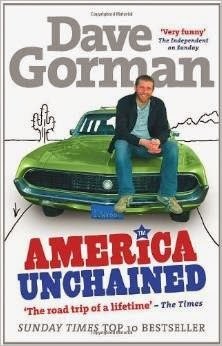 I bought this book as holiday reading, expecting a humorous travel book, and though the humour is there, it proved to be more of a straight tale - but was none the worse for that. After suffering a comedy tour staying in bland chain hotels, Dave Gorman decided to try to cross America from coast to coast without giving any money to 'the Man', avoiding chain hotels, chain restaurants and chain filling stations.
I bought this book as holiday reading, expecting a humorous travel book, and though the humour is there, it proved to be more of a straight tale - but was none the worse for that. After suffering a comedy tour staying in bland chain hotels, Dave Gorman decided to try to cross America from coast to coast without giving any money to 'the Man', avoiding chain hotels, chain restaurants and chain filling stations.As is often the case with these kind of books, the car itself (regularly breaking down) is one of the main characters, as is the video cameraperson who is Dave's companion as he attempts this remarkable feat. Despite a total disaster part way through (which reduces the vegetarian author to eating three burger meals, one each from McDonalds, Burger King and Wendy's in protest, with dire consequences) the feeling is mostly upbeat, and inevitably provides a fascinating exploration of small town America: charming and wonderful at its best, unfriendly to strangers and downright scary at its worst.
While I would have appreciated a touch more humour, as Bill Bryson managed so well in his early travel books, Gorman kept my interest throughout and made his remarkable road trip well worth the read. If you'd like to find out more about small-town America (and how it is disappearing) from a British viewpoint, it's highly recommended.
You can find out more at Amazon.co.uk and Amazon.com.
Published on August 28, 2014 02:31
August 27, 2014
The surprising chemistry of Osmium Tetraoxide

When it comes to elements we meet in everyday life, osmium doesn’t come high on the list. Let’s face it, a metal that is best-known for being used in an alloy in fountain pen tips isn’t exactly the substance-de-jour. Yet its compound with oxygen, osmium tetraoxide, is both versatile and surprising.
Discover more in my latest Royal Society of Chemistry podcast about osmium tetraoxide. Take a listen by clicking play on the bar at the top of the page - or if that doesn't work for you, pop over to its page on the RSC site.
Published on August 27, 2014 01:35
August 26, 2014
Reamde review
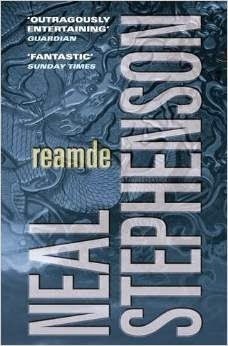 Like most people who have worked a lot with computers, I immediately saw the title of Neal Stephenson's book Reamde as a variant on 'Readme' - as indeed it is. I've really enjoyed his science fiction work like
Cryptonomicon
and Anathem before, and have even managed to overcome my loathing of extremely long books, as in these works Stephenson is not indulging in drivel, but really fills them with content. However, Reamde has left me with very mixed feelings.
Like most people who have worked a lot with computers, I immediately saw the title of Neal Stephenson's book Reamde as a variant on 'Readme' - as indeed it is. I've really enjoyed his science fiction work like
Cryptonomicon
and Anathem before, and have even managed to overcome my loathing of extremely long books, as in these works Stephenson is not indulging in drivel, but really fills them with content. However, Reamde has left me with very mixed feelings.I loved the plot segment that the book's title refers to. Reamde is a virus that takes computers hostage, linked to a massive multiplayer online game called T'rain, which was created as a way of using the virtual coinage inside the game for far more than simply buying a new sword. If you are interested in computer gaming, the parts of the story that revolve around the game are brilliant - as is the twist of the virus resulting in an organised crime gang trying to track down its creator.
However, this only accounts for around 1/4 of the 1,000 plus pages, and I was far less happy with the rest. Firstly, while the multiplayer game storyline is borderline SF, the rest is just a straightforward action thriller with good guys versus evil jihadists. This mostly consists of two huge set piece battle sections, each lasting several hundred pages. I'm not particularly interested in this kind of storyline, which despite being page turning in its intensity at the peaks had a lot of dull troughs. It didn't help that where previously Stephenson's expansive writing was a result of having lots of content, in the battles it really did feel like there was far too much padding and I found myself skipping whole pages at a time to get to something happening. I'm afraid he has strayed into late J. K. Rowling-itis - too famous now for an editor to dare to suggest cutting out the woffle.
Two more issues. Stephenson uses a large numbers of points of view, which I find tedious - while the T'rain part of the story was running I wanted to switch back to the main character's view, and got irritated with all the switches away, while in the battle scenes, and pretty much the last half of the book, the main character hardly features at all and is just a minor character of many - this isn't my favourite style of writing.
The final problem probably reflects my being British. The good guys are pretty well all rabid gun enthusiasts, which plays a major part in the storyline. I'm afraid this just leaves me cold - it was, at times, as if two lots of terrorists were fighting each other. I appreciate that this may have been in part to reflect the nature of battle in an adventure game, drawing real world parallels, which was decidedly clever, but it still left me feeling the 'good' guys all deserved to be locked up at the end for the safety of everyone else. Only the sheer momentum of the writing carries you past the fact that their response to have having an armed hoard of terrorists on the loose is not to call in the authorities but to try to kill them themselves.
This, then, was a book with lots of promise in what should have been its main theme, that became hijacked to become a very lengthy action thriller. Disappointed.
Many people no doubt disagree - you can see alternative viewpoints at Amazon.co.uk and Amazon.com.
Published on August 26, 2014 02:41
August 19, 2014
Jehovah lite
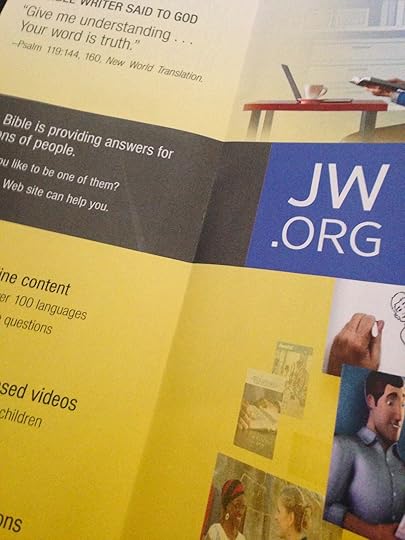 The much improved designWe were sitting at breakfast and the others saw someone approaching the door. I was sitting with my back to the window, so didn't realize what was about to happen. The doorbell rang.
The much improved designWe were sitting at breakfast and the others saw someone approaching the door. I was sitting with my back to the window, so didn't realize what was about to happen. The doorbell rang.'You go,' they said.
'It's Jehovah's Witnesses, isn't it?' I asked.
They just smirked.
And it was, but interestingly this was a JW visit lite. Rather than attempt to engage me in conversation, the female member of the (inevitable) pair just told me they were distributing these leaflets across the country and gave me one. And went. So I was immediately in a good mood, as the toast was still warm.
The good news about the leaflet is that they've finally hauled the typography into the 21st century. The old JW leaflets were so old fashioned looking, and very alien in presentation for a UK audience - they were very obviously American. I'm not talking spelling, but rather the design just wasn't the way a UK leaflet looks. Now, as you can see, they've improved things enormously.
It's only 8 out of 10, though, guys. Why not 10? The paper is still wrong. I don't know why, but US leaflet paper feels totally different - less glossy, more flimsy, than UK leaflet paper: and this was still wrong.
As for the content,this was also much more clever. Just one Bible quotation. Mostly advertising the free resources on their website. In fact with its 'Where can we find answers to life's big questions?' header, it was very reminiscent to the advertising you see on posters for an Alpha course. The front also says 'Are the answers in... Science? Philosophy? The Bible?' And then inside we read that 'the Bible is providing answers to millions of people.'
Clever again, as it's not explicitly knocking science - though we clearly get the message that science can't answer life's big questions. In case you aren't sure what these are, the back suggests:
What is the meaning of life?Is God to blame for our sufferings?What happens when you die?My suspicion is that for many people these questions aren't as big as various ones that science can probably do better at than the Bible. For instance, the (old testament) Bible is pretty strong on mass extermination of your enemies, and I'm pretty sure that isn't the right answer with the various Middle East problems underway at the moment.
For me, that highlights the mistake of comparing the Bible and science as an answer to some problems. Although I admit there will always be alternative theories under development, at any one time, science has a single, mainstream consensus answer - our current best theory. The Bible and other religious texts, though, can almost always deliver conflicting answers, so you choose the one that suits your preferences. How to deal with your enemy? If you're a hawk, you can use the Old Testament as the reason for smiting them and wiping them out to the very last person (children included). If you're a dove, you can use the New Testament to make it obvious that loving them and turning the other cheek is the answer.
So, well done Jehovah's Witnesses for pointing out the underlying flaw in your own argument. I'm impressed.
Published on August 19, 2014 01:20
August 15, 2014
Superconducting sewage
 One of the joys of writing a book like
The Quantum Age
(still just 99p on Kindle) is discovering new and interesting things - and one I particularly enjoyed was the deployment of quantum technology to deal with sewage.
One of the joys of writing a book like
The Quantum Age
(still just 99p on Kindle) is discovering new and interesting things - and one I particularly enjoyed was the deployment of quantum technology to deal with sewage.Finding superconductors in powerful electronic devices and scanners may not be too much of a surprise, but a surprising example of an application of superconductivity - a totally quantum phenomenon - is a million miles away from the delicacy of Josephson junction powered SQUIDs (Superconducting Quantum Interference Devices). It is in sewage treatment. We live in a paradoxical world that is awash with water – it almost defines our planet – and yet at the same time where there is a shortage of clean drinking water. It shouldn’t be that way. The world contains around 200,000,000,000 litres of water for every living person.
If you think of that in terms of consumption, assuming a typical 5 litres a day, the water out there should last over 100 million years. And that would be if it were all used up, where we know in practice that most of the water we consume is released back into the environment in short order. Of course that 5 litres only represents our direct consumption. A typical Western water user will be responsible for up to 10,000 litres a day. In part this is due to washing, watering the garden and flushing the toilet, but also because of the indirect use in the production of the goods we buy and the foods we eat. Just one hamburger takes around 3,000 litres, while a 1 kg jar of coffee requires a massive 20,000 litres. (Though once again, most of this water will be recycled – it doesn’t remain in the product.)
The problem, of course, comes not from poor availability of water per se, but the lack of clean drinking water in the right place for those who need it. Arguably this makes any water shortage more of an energy problem than anything else –that’s the energy required to clean up the water, whether it is desalination or removing dirt and sewage, and to get the water to where it is needed. And superconductivity can play its part in overcoming this. Most existing waste water treatment – whether cleaning up sewage or cleaning water from a river to use in an industrial plant – is expensive to build and has to be on a large scale to be cost effective. There are many circumstances where a smaller, distributed system would work better and, surprisingly, superconductors offer a solution to cleaning water that is both more cost effective and compact than a conventional treatment plant. What’s more it works more quickly too.
The process makes use of a powerful superconducting magnet to separate off the suspended material in the water. This is obviously fine for magnetic metals, but it seems an unlikely solution for the rest – the typical gunk that we associate with sewage and polluted water. But by adding a substance known as a ferromagnetic adsorbent to the water this mess become accessible to magnetic fields. The suspended particles stick the adsorbent material, which is then dragged out of the water by the magnets leaving clean water behind. The only way to get a sufficiently strong magnetic field is to use superconductors. Quantum physics to the rescue.
Published on August 15, 2014 02:31
August 14, 2014
A great guide to some classic SF
 Younger readers may not have come across some of the classics of science fiction, so I'm grateful for Pete Young for assembling around 250 reviews of these great books in issues 3 and 4 of his fanzine Big Sky. (There are a couple of my reviews in issue 3, though that's not why I'm recommending this.) Specifically, these reviews cover the books that were re-issued in the excellent Gollancz SF Masterworks series.
Younger readers may not have come across some of the classics of science fiction, so I'm grateful for Pete Young for assembling around 250 reviews of these great books in issues 3 and 4 of his fanzine Big Sky. (There are a couple of my reviews in issue 3, though that's not why I'm recommending this.) Specifically, these reviews cover the books that were re-issued in the excellent Gollancz SF Masterworks series.To be honest, I've never been a great enthusiast for the whole fan fiction/fanzine scene, because time is limited and I haven't enough to read all the 'real' stuff without getting onto the fan work, however good it is. But I have to say these are good quality productions (best read on a tablet, I suspect) and free too, so well worth a look.
You can download Big Sky from http://efanzines.com/bigsky/index.htm
Published on August 14, 2014 02:21
August 13, 2014
Funny serious psychopathy
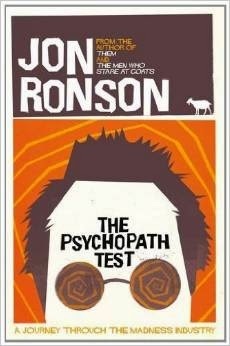 During the panel session at our Guardian masterclass on science writing, the excellent author M. G. Harris recommended Jon Ronson's The Psychopath Test. I had already read and enjoyed The Men who Stared at Goats (even though Professor Brian Josephson assures me I gave too much attention to the 'staring at goats' issue in my book
Extra Sensory
), so had no hesitation on buying this book on M. G.'s recommendation - and it is even better.
During the panel session at our Guardian masterclass on science writing, the excellent author M. G. Harris recommended Jon Ronson's The Psychopath Test. I had already read and enjoyed The Men who Stared at Goats (even though Professor Brian Josephson assures me I gave too much attention to the 'staring at goats' issue in my book
Extra Sensory
), so had no hesitation on buying this book on M. G.'s recommendation - and it is even better.The book starts with a mystery - a strange, expensively produced book that is being sent to a number of academics. No one knows what it means, or who has written it. Ronson solves this mystery, which leads him to taking the plunge into what he describes as the 'madness industry'. It might seem this is a subject that couldn't produce much humour, but what Ronson does so well is brings out the essential human funny bits, while not holding back on some of the surprising and sometimes horrific realities.
Whether he is dealing with a man who apparently is in a secure unit because he pretended to be mentally ill to avoid a jail sentence and now can't get out, to the mind-boggling possibility that over a million US children are being medicated for a mental condition that most of the rest of the world doesn't think exists, the book is a wonderful set of revelations, all tied together in an effortless, page-turner style.
Like Louis Theroux on TV, you sometimes get the feeling that the author is being a touch manipulative, telling us just a bit too much of his own anxieties and feelings to get us engaged - but you can forgive Ronson, because these are just such good stories, so well told.
Is it all true? You could almost say some of this stuff is so weird you couldn't make it up. I think it probably is, even if coloured a little to make the story tell well. Take the plunge and you will meet some fascinating and scary people, understand a lot more about why mental health issues are so difficult to deal with (anything that is diagnosed by the percentage score on a checklist is, at least, worrying) and realise that whether you love or hate psychiatry, there were some prejudices you had that were wrong. Oh, and there are even Scientologists. (Who really hate psychiatry.) What's not to love. Great holiday reading.
Find out more at Amazon.co.uk or Amazon.com.
Published on August 13, 2014 01:28
August 12, 2014
Graphene's little brother
 I'm not a great one for using press releases as blog posts (although, come on, it is the silly season), but this one was so interesting, I wanted to share it.
I'm not a great one for using press releases as blog posts (although, come on, it is the silly season), but this one was so interesting, I wanted to share it.It's about silicene, which is the silicon equivalent of graphene, a single atom thick sheet of the substance. Just as graphene has proved an incredibly versatile material, the same is likely to prove true for silicene (which the spellchecker keeps trying to change to silicone - sigh). It's early days, but watch this space. Here's what the IoP had to say:
An international team of researchers has taken a significant step towards understanding the fundamental properties of the two-dimensional material silicene by showing that it can remain stable in the presence of oxygen.
In a study published today, 12 August, in IOP Publishing’s journal 2D Materials, the researchers have shown that thick, multilayers of silicene can be isolated from its parent material silicon and remain intact when exposed to air for at least 24 hours.
It is the first time that such a feat has been achieved and will allow scientists to further probe the material and exploit the properties that have made silicene a promising material in the electronics industry.
Silicene is made from single, honeycomb-shaped layers of silicon that are just one atom thick. At the moment, silicene must be produced in a vacuum to avoid any contact with oxygen, which could completely destroy the formation of the single layers.
Silicene must also be “grown” on a surface that matches its natural structure — silver is the leading candidate. To create silicene, a wafer of silicon is heated to high temperatures, forcing single silicon atoms to evaporate and land on the silver substrate, forming the single layer.
Silicene can also be transformed from a 2D material into a 3D material by stacking more and more single layers on top of each other. However, previous research has demonstrated that silicene has “suicidal tendencies” and always reverts back to silicon as more layers are added, because a silicon structure is more stable.
In this new study, an international team of researchers based in Italy and France fabricated multilayers of silicene using a silver substrate kept at a temperature of 470 K and a solid silicon source, which was heated to 1470 K. A total of 43 monolayers of silicene were deposited onto the substrate.
Once fabricated, the researchers observed that a very thin layer of oxidation had formed on top of the multi-layered stack of monolayers; however, it was shown that this preserved the integrity of the stack, acting like a protective layer.
The stack of monolayers remained preserved for at least 24 hours in open air, in which time the researchers were able to use x-ray diffraction and Raman spectroscopy to confirm that the material was in fact silicene and not ordinary silicon.
Lead author of the study Paola De Padova, from Consiglio Nazionale delle Ricerche in Italy, said: “These results are significant as we have shown that it is possible to obtain a silicon-based 2D material, which up until a couple of years ago was deemed inconceivable.
“Our present study shows that multi-layered silicene is more conductive than single-layered silicene, and therefore opens up the possibility of using it throughout the silicon microelectronics industry. In particular, we envisage the material being used as gate in a silicene-based MOSFET, which is the most commonly used transistor in digital and analog circuits.
“We are currently studying the possibility of growing multi-layered silicene directly onto semiconductor substrates to explore the joint superconducting properties.”
"Silicene Cluster" by Ayandatta - Own work. Licensed under Creative Commons Attribution-Share Alike 3.0 via Wikimedia Commons - http://commons.wikimedia.org/wiki/Fil...
Published on August 12, 2014 02:48
August 11, 2014
All the fun of the Astrofair
 On Saturday I spent an extremely entertaining day in Sidmouth, not on one of the town's beaches, but instead at an astronomical observatory.
On Saturday I spent an extremely entertaining day in Sidmouth, not on one of the town's beaches, but instead at an astronomical observatory.I confess that, while I knew about Norman Lockyer, I wasn't aware of the Norman Lockyer Observatory - and it's a wonderful find.
Lockyer was a professor at Imperial College (or, rather, its predecessor) and one of his main studies was the Sun. Using spectroscopy - splitting the light from the Sun into a colour spectrum, where dark lines indicate the presence of atoms that are absorbing particular energies of photons - Lockyer discovered a puzzling line in the yellow band, which had not been seen before. He had discovered an element that had not yet been found on the Earth, and named it after the Greek word for the Sun, helios. As well as discovering helium, Lockyer brought another significant presence of modern science into being when he founded a journal called Nature, one of the most prestigious scientific journals today.
When he retired to Devon, Lockyer established an observatory, which has grown to be today's Norman Lockyer observatory. Apart from a handful of telescope domes, the facilities now include an excellent lecture theatre and planetarium, and, for the fair on Saturday, an array of marquees that took me back to my youthful delight in all things astronomical. If the cash had been available I could have spent thousands on the technology on sale - and even without cash I was pressed into taking part in an experiment when I dared to enter the Institute of Physics tent.
I was there primarily to give a talk, based on Before the Big Bang , which seemed to go down well - but also took part in the fair and spent a lot of time next to a fascinating stand where a collection of stellar spectra on glass plates, mostly over 100 years old, was on display and could even be picked up and looked at. The archive, under the aegis of Exeter University and the Observatory, has apparently over 7000 of these plates which need cataloguing (the old catalogue was lost) and scanning in high res to preserve their delicate and valuable contents - after all these are records of spectra made before the light pollution we so decry to today.
All in all a brilliant day, and if you are anywhere near the West Country, I urge you to turn up at next year's fair - or at one of the observatory's many other events through the year. You can discover their programme and much about it at their rather quirky (bear with it) website.
I just wish I had taken some photos - but I was having too much fun!
Published on August 11, 2014 01:17
August 8, 2014
What's your digital quotient?
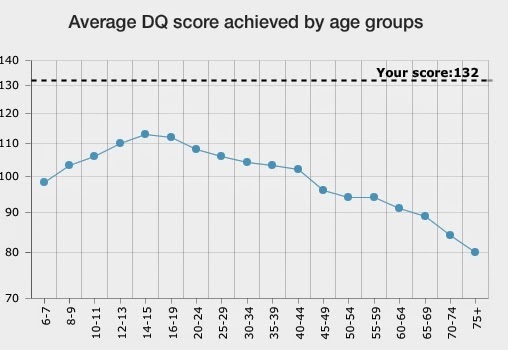 Take that 6-7 year olds!According to the news, the communications watchdog Ofcom has told us that 'the average six-year-old child understands more about digital technology than a 45-year-old adult.' (To be precise, that quote is from this Guardian report.)
Take that 6-7 year olds!According to the news, the communications watchdog Ofcom has told us that 'the average six-year-old child understands more about digital technology than a 45-year-old adult.' (To be precise, that quote is from this Guardian report.)Looking at the actual data, the Guardian statement is a little naughty, as I doubt very much that the difference between the scores of 6-7 year olds and 45 year olds is statistically significant (see how close they are in the chart alongside). However there is no doubt there is a point here. Most of us older folk (as you'll see from the line at the top of the chart, me excepted) are pretty poor at coping with technology compared with da yoof.
This isn't really news. It's quite a while since those many jokes about how people had to get their children to set the timers for their video recorders for them (remember video tapes, kiddies?) because they couldn't cope with them. But by setting up a measure, the so-called 'Digital Quotient' or DQ, Ofcom is trying to quantify the position. Given the way that the concept of IQ has been found decidedly wanting, I do think it's a shame that marketing people can't get enough of xQ measures, but that's by-the-by.
Back in my (relative) youth, I helped set up the PC centre for a large company, providing assistance for those struggling with the new technologies. (And yes, I really did have someone ring me up, worried that they might catch a computer virus.) I found back then, and I think it's still true today and reflected in this graph, that there was one huge dividing factor between those who coped easily with PCs and those who struggled. It was fear.
The users who were scared of their computers, terrified of losing stuff or doing the wrong thing, struggled mightily. Those who just plunged in and had a go, treating the whole thing a bit like an adventure game got on easily. I do actually wonder if the fact that my first experience of interactive computing, as opposed to batch computing with punched cards, was playing ADVENTURE on the George III-based ICL system at Lancaster University helped. I was used from the beginning to plunging in, looking around, seeking what I can find and using it.
I still find this today if someone asks me, say, how to do something in Word. My answer is 'I can't tell you how to do it, because I don't know how, but if you give it to me I'll fiddle around and find it.'
I'm not sure if the solution to the problem Ofcom is highlighting is to send all those with low DQs into Colossal Caves to do a bit of adventuring, but we certainly need to encourage them to lose that fear. There might be a little pain along the way - notably learning to ensure that everything is well-backed up - but we could certainly do with a computing mantra along the lines of 'There is nothing to fear but fear itself.'
You can have a go yourself with a simplified version of the DQ test here.
Published on August 08, 2014 01:06



